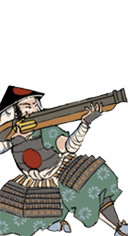
Basic Unit Statistics (can be modified by difficulty level, arts, skills, traits and retainers)
| Recruitment Cost | 850 | |
| Upkeep Cost | 125 | |
| Melee Attack | 2 | 5% |
| Charge Bonus | 5 | 10% |
| Bonus vs Cavalry | 0 | 0% |
| Range | 250 | 38% |
| Accuracy | 35 | 35% |
| Reloading Skill | 20 | 20% |
| Ammunition | 5 | 6% |
| Melee Defence | 1 | 2% |
| Armour | 1 | 6% |
| Morale | 3 | 6% |
Strengths & Weaknesses
- Fires large numbers of explosive rockets.
- Shorter range than other siege weapons.
- Shots hit over a very large area.
- Very weak in melee.
Requires
Description
These men are armed with large arquebuses loaded with wooden rockets that are ignited and fired into enemy ranks to cause fires and panic.
Because they are launched from hand-held arquebuses, fire rockets are much more mobile than siege weapons. However, they are less powerful and accurate than cannons, and are not used to batter down the walls of a castle. Instead they fire over the top of walls: the rockets' high arc and long range lets them rain down on the enemy below, setting buildings alight, sowing panic and destroying morale in the process. During the Sengoku Jidai, the Japanese used incendiary weapons such as fire bombs and fire rockets in naval warfare. Kobayakawa Takakage of the Mori clan used rocket-loaded arquebuses to bombard enemy ships, and many vessels would carry a unit of fire bombers or a small catapult to launch flammable projectiles. Japanese vessels resembled large, floating wooden castles, and another tactic was to simply moor your ship next to your enemy, board it and fight to the death as if the ships were fortifications on land!